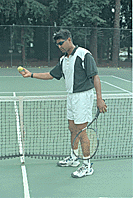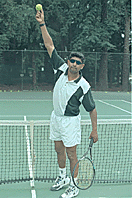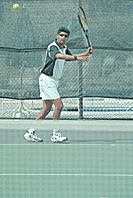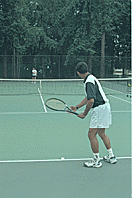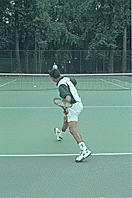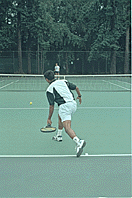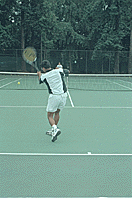|
TennisOne Lessons
Part 2The Straight Back Forehand
QuestionI have a loopy backswing on my forehand racquet take back. I use a semi-western grip to get lots of topspin on the ball. The problem I am running into is when I am faced with an opponent who mixes up the spin and pace on the ball. I seem to frame the ball a lot and not find my range or rhythm. My friends tell me I should eliminate my loopy backswing. I don't want to do that because the loopy backswing gives me a lot of pace and topspin. What should I do? AnswerNot to worry. Most loopers have problems with opponents who topspin on one side and keep the ball low with slices on the other. By knowing when to loop and when to take it straight back, you'll find your range and rhythm. In Part 1 of this lesson we covered the what, who, why and how of the loopy forehand. Now that you understand the fundamentals, we can go into detail in Part 2 of the lesson on when and how to hit with the loopy forehand and when to hit the forehand by taking the racquet straight back. In this part of the lesson we'll focus on two key issues:
Type of spin your opponent is placing on the ballAs soon as the ball leaves your opponent's racquet and while it's still on his side of the net, you must learn to see and read the spin on the ball. A good way to recognize the spin on the ball is by taking note on the way your opponent likes to swing at the ball. A low to high swing means topspin; a high to low swing means underspin or slice. Sounds simple but remember, you have to see the swing with your peripheral vision while at the same time your eyes are glued to the ball that is about to be struck. If you are having problems reading the spin on the ball, here's a simple drill that will help. Get a practice partner to feed you slice and topspin balls. While he is about to hit the ball, concentrate on his racquet and the way he swings. Now call out "topspin" or "slice" before he connects. Once you get good at this drill, do the same thing, but this time concentrate on the ball instead of the swing. The height of the ball when it clears the net
Remember, once you are able to read the spin and height of the ball when it clears the net, then and only then, can you determine whether to take your normal loop or the set it back straight.
To take the racquet back straight, have the racquet head below the shoulder and roughly at your waist height as I am doing here. Keep in mind, the balanced footwork, the good shoulder coil and bent knees are all the same, the only thing different is that you are eliminating the loop on the backswing. By doing so, you will eliminate the extra racquet head motion so it becomes a lot easier to get under the ball and erase all the miss hits from your stroke. Recap: To Loop Or NotLoop when you know the ball is going to bounce at least your waist height or higher. This means the ball has to have topspin on it. To loop imagine making a letter "C" as you set the racquet back. Take the racquet straight back when you know the bounce of the ball is going to be lower than your waist level. For this to happen the ball has to have a lower net clearance and has to have some underspin on it. Take the racquet back roughly your waist height.
Click here to see animation of forehand with loopy racket take-back. Click here to see animation of forehand with straight racquet take-back.
Send email to the author We encourage you to email your comments (pro, con, appreciative,
whatever) directly to the author. To send email to Monty Basnyat, click here. Go To: Back to TennisONE Home Page webmaster@tennisone.com
|
